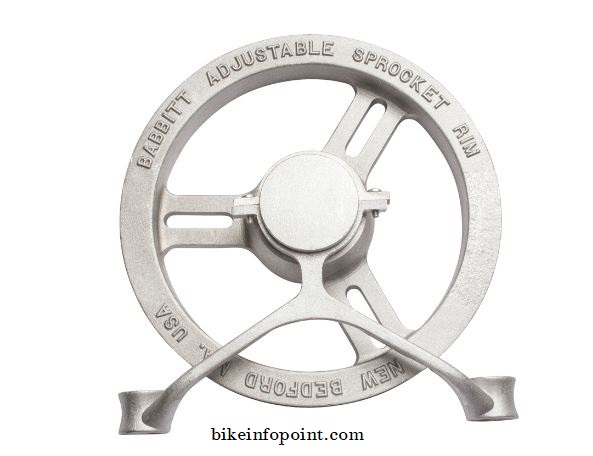
Solid Hub Chainwheel
A hub chainwheel is a type of chainring that is integrated into the hub of a bicycle’s rear wheel. It is an alternative to the traditional chainring, which is attached to the crankset located at the bottom of the bike’s frame.
The hub chainwheel is an important component of the drivetrain of a bicycle. Because it plays a role in transmitting power from the pedals to the rear wheel. It is responsible for converting the rotational movement of the pedals into linear motion, which propels the bike forward.
A solid hub chainwheel is a specific type of hub chainwheel that is made from a single piece of material, typically aluminum or steel. This construction allows for increased durability and strength compared to traditional chainrings, which are typically made from multiple pieces of material and are prone to breaking or bending.
The solid hub chainwheel is an innovative and effective solution for bicycles that require a reliable and low-maintenance drivetrain. It is especially well-suited for use in heavy-duty bikes, such as cargo bikes and e-bikes, which may experience higher levels of stress and wear on their drivetrain components.
Table of Contents
ToggleHow a Solid Hub Chainwheel Works

A solid hub chainwheel consists of several key components, each of which plays a specific role in its function:
Chainring teeth: These are the raised ridges on the outer circumference of the chainwheel that engage with the chain and transmit power from the pedals to the rear wheel. The number and spacing of the teeth can vary, and can impact the smoothness and efficiency of the drivetrain.
Hub: The hub is the central part of the chainwheel that houses the bearing system and connects it to the rear axle of the bicycle. The hub is typically made from a strong and lightweight material, such as aluminum or carbon fiber, and is designed to withstand the stresses of pedaling and road conditions.
Bearings: The bearings are what allow the hub and chainwheel to rotate smoothly. They are typically made from high-quality materials, such as stainless steel or ceramic, and are designed to minimize friction and wear.
To understand how a solid hub chainwheel works, it’s helpful to know how a traditional chainring works as well. When a rider pedals, the force is transmitted through the crankset and chainring, which rotates the chain. The chain then wraps around the sprockets on the rear wheel, which drives the wheel forward.
In a solid hub chainwheel, the chainring teeth and hub are integrated into a single unit that is attached to the rear axle of the bike. When the rider pedals, the force is transmitted directly through the hub and chainring teeth to the rear wheel, eliminating the need for a traditional crankset and chainring. This design allows for a simpler, more efficient, and more durable drivetrain.
Advantages of a Solid Hub Chainwheel
There are several key advantages to using a solid hub chainwheel on a bicycle:
Improved durability and longevity: One of the primary benefits of a solid hub chainwheel is its increased durability and longevity. Because it is made from a single piece of material, it is less prone to breaking or bending than a traditional chainring, which is made from multiple pieces and is more susceptible to damage.
Reduced maintenance requirements: Another advantage of a solid hub chainwheel is that it requires less maintenance than a traditional chainring. Without the need for a chainring bolt or bolt circle diameter there are fewer components that can loosen or wear out, which means fewer adjustments and replacements are needed over time. This can save time and money on maintenance, as well as increase the overall reliability of the bike.
Increased reliability: Because of its increased durability and reduced maintenance requirements, a solid hub chainwheel can provide increased reliability for riders. This can be especially important for commuters or others who rely on their bike for daily transportation. Because a reliable drivetrain is crucial for getting from point A to point B.
Disadvantages of a Solid Hub Chainwheel
While a solid hub chainwheel offers several benefits, there are also some potential drawbacks to consider:
Limited gear options: One potential disadvantage of a solid hub chainwheel is that it may offer fewer gear options compared to a traditional chainring. Because the gears are integrated into the hub, it may not be possible to easily swap out different sizes or ratios as desired. This can be a drawback for riders who need a wide range of gears for different terrain or cycling conditions.
Potential for increased weight: Another potential drawback of a solid hub chainwheel is that it may be heavier than a traditional chainring. Because it is made from a single piece of material and includes the hub, it may be heavier than a traditional chainring and crankset combination. This can be an issue for riders who are looking to minimize the weight of their bike, particularly for performance or racing purposes.
Reduced versatility: A solid hub chainwheel may also be less versatile than a traditional chainring, as it may not be compatible with all types of bikes or cycling styles. For example, it may not be suitable for use on road bikes or mountain bikes that require a wide range of gears or a more complex drivetrain setup.
While a solid hub chainwheel can offer several benefits, it may not be the best choice for every rider or every type of bike.
Ultimately, the decision to use a solid hub chainwheel will depend on your specific cycling goals and needs. It’s always a good idea to research and compare different options before making a decision and to consider the pros and cons of each option carefully.


